A selection of the best holistically sustainable grape varieties and recommendations for their selection
Despite the fact that grapes are a southern crop, they are grown both in the middle zone and in the north of Russia. The plant must be immune to fungal and viral diseases and successfully resist insect pests. For growing in unpredictable climatic conditions, frost-resistant and drought-resistant crops are chosen. Gardeners say that holistically sustainable grape varieties have all these advantages. What this concept means and which grapes are recognized as the most sustainable, we will consider further.
What are holistically sustainable grape varieties?
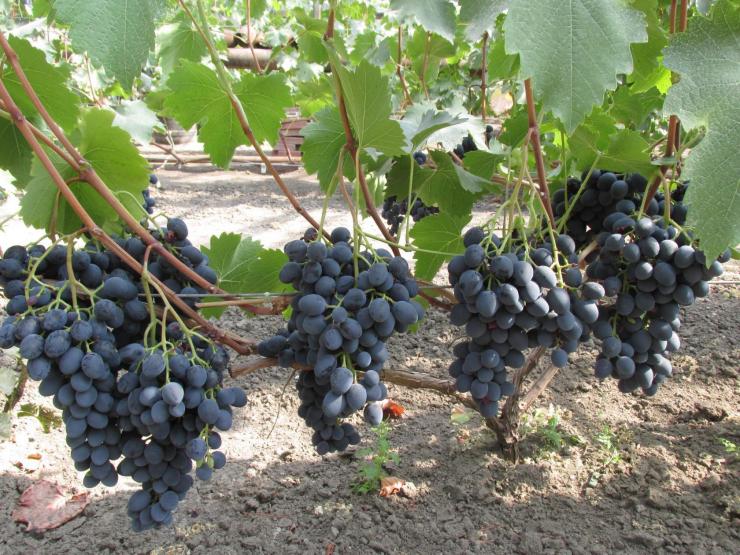
Complex sustainability is the ability of a crop to withstand external factors and growing conditions: diseases, pests, frost and drought, sudden changes in weather.
This criterion is assessed on a scale using the stability coefficient - the higher it is, the lower the value:
- 1 point - extremely rarely affected by common crop diseases (oidium, gray mold, mildew);
- 2 points - highly resistant to diseases and pests;
- 3 points - average susceptibility;
- 4 points – severely affected by diseases (25–50%);
- 5 points - very affected by diseases.
There is an opinion that complexly resistant varieties do not require fertilizing, fertilizers, or treatment against diseases and pests.This is incorrect, since any grape bears fruit better and shows greater productivity with regular preventive and strengthening measures.
Top best
What are the best holistically sustainable grape varieties? When choosing, it is recommended to pay attention to the ripening period and growing conditions, yield indicators and taste of berries, commercial qualities and shelf life.
Kishmish radiata
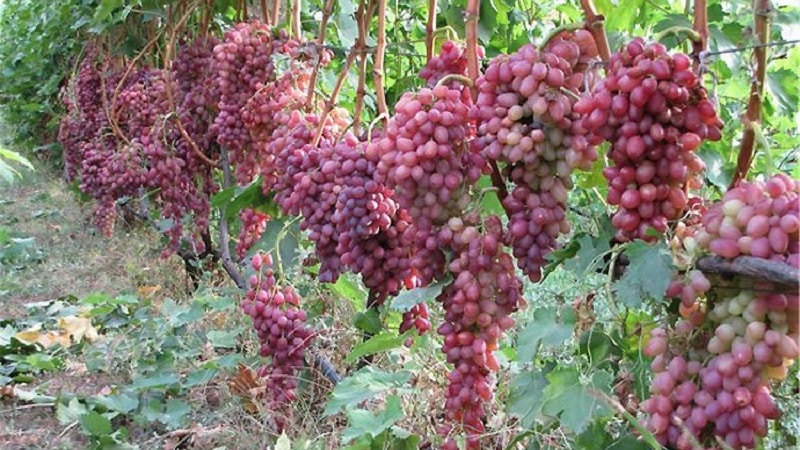
Kishmish - the most popular grape for fresh consumption. The berries have no seeds, the pulp is sweet and tender, and is juicy. The ripening period of the variety is average, the recommended growing region is the North Caucasus (Republic of Crimea, Adygea, Stavropol Territory).
The weight of the bunch is about 400 g, the shape is winged, the density is loose. The berries are ovoid-elongated, the skin is pink and dense. The taste is pleasant, delicate, tasting score - 9.1 points out of 10. The berries are suitable for processing and fresh consumption. When growing, it is recommended to tie the plant to a support and regularly remove shoots and weak shoots.
Flora
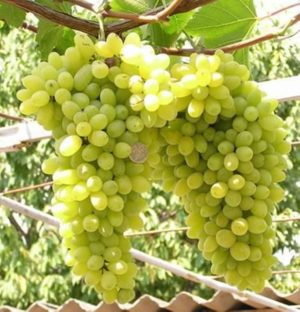
The variety has medium-sized bushes, medium-sized leaves, deep green color. The clusters are conical and winged, weigh about 1 kg, some specimens reach 2.5 kg. The berries are oval-oblong, weigh 8–10 g each, and have a thin skin.
The color is white-green, a slight tan appears in the sun, and there is a waxy coating. The taste is juicy and sweet, the flesh is crispy, with 2-3 small seeds. The flora is valued for its most attractive presentation, resistance to mildew and powdery mildew, and versatility in use - cocktails and juices, jams and preserves, confitures and marmalade are prepared from grapes.
Bogotyanovsky
The table variety is persistent, the ripening period is early. The bushes are vigorous, the leaves are green and bristly, the flowers are bisexual.The clusters are medium in size, cylindrical-conical in shape, average weight - 400 g.
The berries are yellow-green, oblong, the flesh is gristly and juicy, the seeds are small. The taste is sweet, tasting score - 9 points.
Attention! Any grape needs complex nutrition: nitrogen is responsible for the development of shoots, phosphorus is required for fruit set and ripening of bunches, potassium prepares the bush for winter, and copper increases frost resistance. Suitable mineral components are contained in Kemira or Magic Watering Can fertilizers. Before use, it is important to carefully read the instructions and safety rules.
One of the advantages of the variety is the transportability of the fruits: they do not deteriorate during transportation, retain their taste and commercial quality. Bogotyanovsky's resistance to mildew and gray rot is higher than standard varieties.
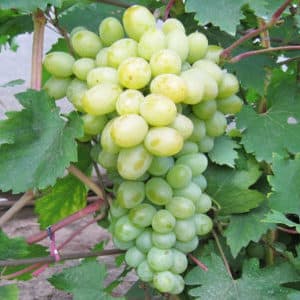
Agat Donskoy
The bushes are vigorous, the shoots ripen quickly, the leaves are slightly wrinkled. Agat Donskoy prefers warm and well-lit lands, pre-treated with mineral and organic fertilizers. The berries are round-oval, blue, weigh about 5 g each.
The skin is durable, with a waxy coating. The clusters are dense, conical-cylindrical, weighing from 500 g to 1 kg. The harvest is processed into juice or wine, eaten fresh, dried or frozen. The taste is sweetish, with tart notes, tasting score - 3.8 points out of 5.
Frost resistance of Agat Donskoy is down to -26°C, seedlings quickly adapt to climatic growing conditions, the plant does not require shelter for the winter. The culture is resistant to mildew and gray rot.
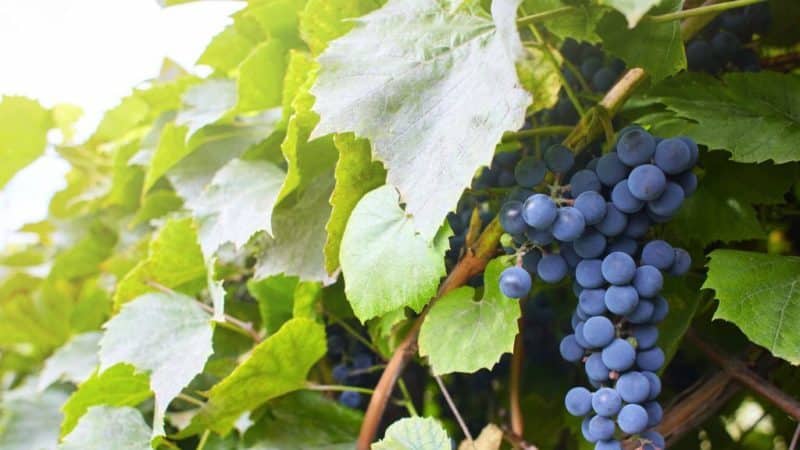
Athos
The harvest ripening period is early, the first fruits are harvested in July. The plant is vigorous, the shoots are strong, and in the first years they acquire a brownish tint.The leaves are dark green, with jagged edges, and have slight pubescence on one side. The flowers are bisexual, which ensures high and stable yields, and does not require wasps or bees for pollination.
The shape of the berries is finger-shaped, with a sharp tip, the color is deep black and blue. The weight of the fruit is about 10 g. The skin is dense, after ripening the berries do not crack, and are suitable for transportation. The weight of a conical bunch is about 1500 g. Athos has a balanced, sweet taste, with a pleasant nutmeg aftertaste. Grapes are used for winemaking and processing.
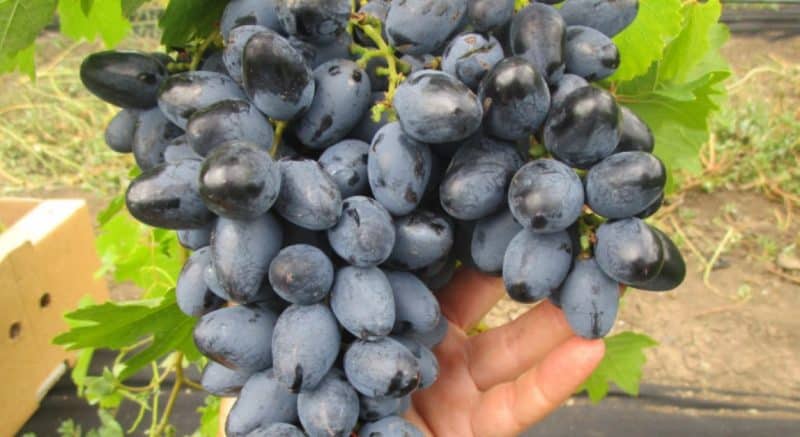
Dubrovsky pink
The frost-resistant variety can withstand temperatures down to -24°C and is suitable for planting in the middle zone. The clusters are loose and winged, reaching 1500 g. The berries are cone-shaped, finger-shaped, weighing up to 20 g. The skin is durable, with a waxy coating, the color is dark pink. The taste is sweet, tasting score - 9.3 points out of 10. The pulp is crisp and tender, with a pleasant berry aroma. The flowers are bisexual - the plant does not need pollinators.
Attention! After harvesting, summer residents prepare the vineyard for winter, fertilizing the soil with organic matter and ash. After all the leaves fall from the bush in the fall, the plant is formed and dry and weak shoots are removed. If the variety is slightly frost-resistant, it is covered for the winter: the vines are bent to the soil, covered with earth in several places, and then with snow.
Dubrovsky pink tolerates drought, is undemanding to care, and bears fruit consistently. The berries are suitable for fresh consumption and any type of processing.
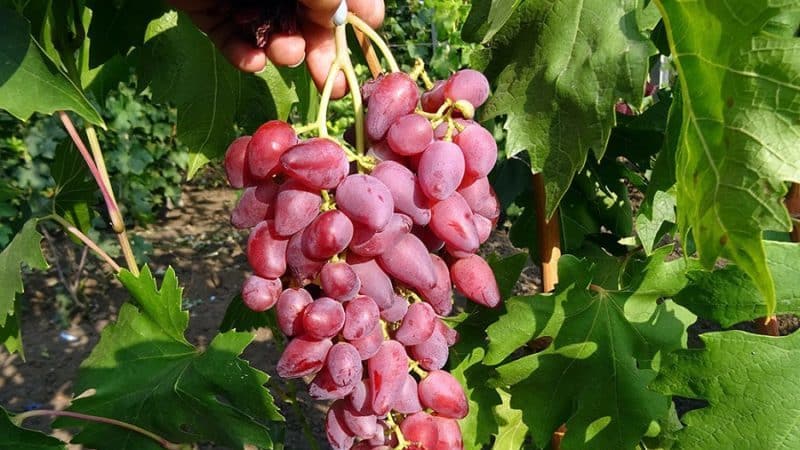
Pleven
The table variety is early ripening; in the southern regions of Russia, the harvest is harvested in early August. The bushes are tall, the vines grow quickly, the leaves are light green. The grapes are valued for their resistance to frost and resistance to fungal diseases and pests.The flowers are bisexual, Pleven is self-pollinating and does not require planting of other varieties.
The clusters are conical, weigh about 300 g. The berries are oval-oblong, the weight of one reaches 5 g. The color is yellow-green, with a slight tan on the south side. The skin is thin but durable, with a waxy coating. The taste is harmonious: sweet, with nutmeg notes, the flesh is tender and juicy. The grapes are suitable for drying, fresh consumption, and processing.
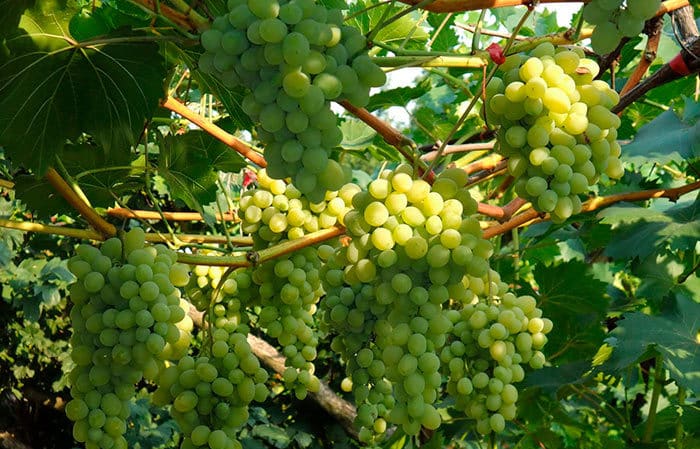
Pineapple
The American variety is resistant to mildew and gray rot and is used in winemaking. Bushes of medium height, cast gray-green, flowers bisexual. The clusters are cylindrical in shape, weigh up to 300 g. The berries are large, oval-round, weighing up to 5 g. The color is rich yellow-green, the flesh is tender, the peel is strong. The taste is sweet, with a pleasant pineapple aroma.
The grapes ripen in the second half of September; in the middle zone of the country they do not need shelter for the winter. Easy to grow, bears fruit consistently, the crop is suitable for transportation and storage. Pineapple is rarely damaged by wasps and aphids; any amateur winegrower can get a rich harvest.
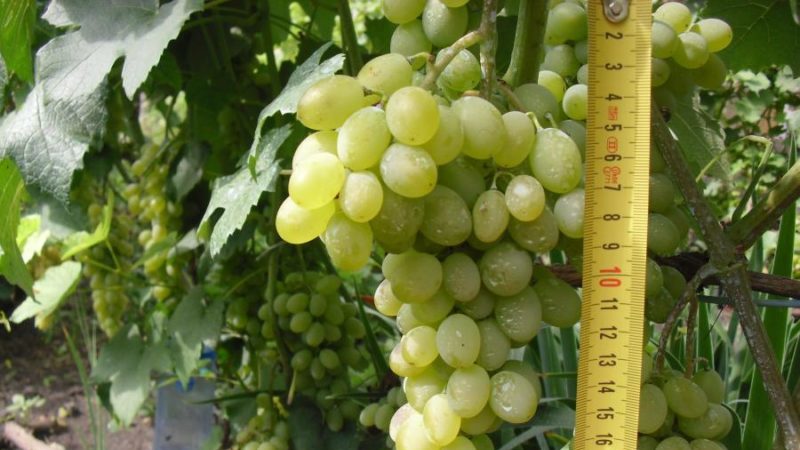
Purple early
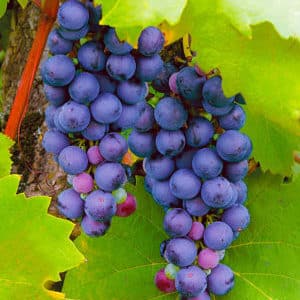
An early-ripening, uncovered variety, harvested in the first ten days of August. The plant is tall, the leaves are deeply dissected, with bristly pubescence. The flowers are bisexual, the clusters are conical, the average weight is 200 g. The berries are elastic, oval-round, weigh 4-5 g.
The color is rich dark purple, there is a waxy coating. The taste is sweet, with a nutmeg aroma, harmonious. Frost resistance of Early Violet is down to -26°C, the berries are not damaged by insects, and immunity to disease is high. Juices, wines, and champagne are prepared from grapes.
The best early-ripening, mid-ripening, late-ripening varieties
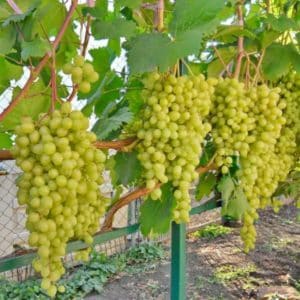
Summer residents distinguish grapes from early varieties Aleshenkin's gift. The harvest ripens in late July–early August, the weight of the bunch is about 500 g, the shape is wide conical. The berries are white, the flesh is pleasant and tender. The variety is characterized by increased resistance to diseases and pests. Also popular is the early ripening variety Gurman Krainova - a table covering variety that is universal in use. The berries are pink, the taste is nutmeg, the pulp is juicy. Tasting score: 9.1 points.
The best mid-season and complexly resistant varieties are Zala Dendy and Krasen. Zala Dendi is a frost-resistant grape, characterized by increased resistance to gray rot. The shape of the bunch is cylindrical, weight - about 270 g. The berries are amber in color, the taste is harmonious, the aroma is sweet. The Krasen variety is unpretentious in care. The berries are blue-violet, the pulp is sugary, pleasant to the taste. The harvest of both plants is suitable for processing and fresh consumption.
Late-ripening variety of complexly resistant grapes Muscat Odessa ripens in October, fruiting lasts 2-3 weeks. The clusters are winged and loose, average weight is 160 g. The berries are small white. Odessa Muscat is used to make wine. There is a late variety Pukhlyakovsky - winter-hardy, rarely damaged by pests. The berries are golden-white, with a green tint, small, and have a harmonious taste. Pukhlyakovsky is suitable for cultivation in any region of the country.
Varieties resistant to mildew and oidium
Mildew and oidium - common diseases of grapes. The reasons for their appearance are improper watering, excess or lack of fertilizers, sudden changes in weather. Some varieties are rarely affected by disease due to their strong immune system. Among them, December grapes are late-ripening and frost-resistant; they do not require shelter for the winter.The weight of the bunch is about 300 g, the shape is cylindrical-conical. The berries are dark purple, the flesh is crisp and harmonious. Jams and juices are prepared from grapes and eaten fresh.
The Arcadia variety is distinguished. The table variety is early ripening, the clusters are large, the average weight is 500 g. The berries are ovoid, yellow-green in color. The pulp is juicy and elastic, the taste is sweet, the aroma is rich berry. Winter hardiness is average - Arcadia requires shelter for the winter.
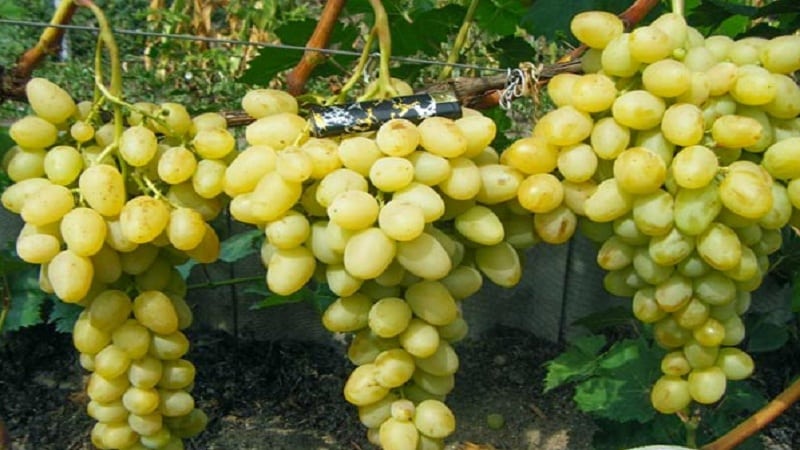
White, dark, pink
White table grape variety White early It is famous for its early ripening, immunity, and frost resistance. The clusters are winged, wide-conical, weigh about 500 g. The berries are large, oblong, the average weight of one is 5.5 g. The taste is simple, the grapes are universal in use. Fruiting is extended, the berries do not fall off or burst.
Pink variety Fantasy - early ripening table variety, unpretentious in cultivation. The berries are cylindrical, the skin is pink and durable. The taste is sweet, with a pleasant aroma. The flesh is fleshy and elastic. Fantasia is valued for its stable yield and versatility.
Black variety Scarlet Tersky technical, used for preparing wine drinks. The ripening period is late, harvested in mid-autumn. The bushes are low, with bristly green leaves, and the shoots are elastic. The clusters are conical, the berries are round-oval. The taste is harmonious and pleasant. Scarlet Tersky is unpretentious in cultivation and does not cover.
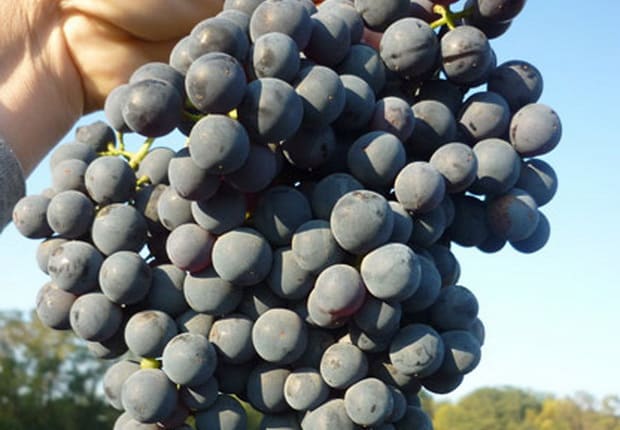
Best for different growing regions
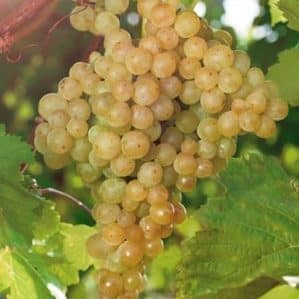
- In the southern regions of the country and Moscow region late-ripening table and technical varieties are grown - Ekim Kara, Shabash, Petit Arvin. The grapes ripen in October and are distinguished by their sweetness and juiciness.
- For central Russia, Urals and Siberia choose frost-resistant early ripening varieties - Pamyati, TSKHA, Preobrazhenie. They bear fruit as early as late July or early August and can withstand low temperatures and sudden weather changes.
- There are varieties that are suitable for growing in any region — Lunny, Moscow dacha, Katyr.
How to choose a holistically sustainable grape variety
First of all, pay attention to the ripening period of the crop and the care requirements. It is recommended to choose those varieties that are slightly damaged by pests, tolerate frost and rain, and do not crumble due to winds. Complexly resistant grapes can be covered or uncovered. The second one causes less trouble when growing.
It is important to remember that there is no ideal variety that would never get sick or be damaged by pests. Good grapes are, first of all, the result of the gardener’s work.
Conclusion
Complexly resistant grapes are little susceptible to diseases and frosts, and are less often damaged by insects than others. The best varieties are Dubrovsky pink, Flora, Athos. Before planting, it is recommended to study the plant descriptions and photos, pay special attention to the ripening time and the recommended growing region. From the early varieties, gardeners distinguish Gurman Krainova or Aleshenkin Dar, from the later ones - Muscat Odessa or Pukhlyakovsky. The berries are tasty and juicy, suitable for fresh consumption and processing.